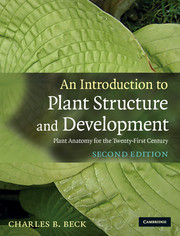Book contents
- Frontmatter
- Contents
- Preface to the second edition
- Preface
- Acknowledgements
- General references
- Chapter 1 Problems of adaptation to a terrestrial environment
- Chapter 2 An overview of plant structure and development
- Chapter 3 The protoplast of the eukaryotic cell
- Chapter 4 Structure and development of the cell wall
- Chapter 5 Meristems of the shoot and their role in plant growth and development
- Chapter 6 Morphology and development of the primary vascular system of the stem
- Chapter 7 Sympodial systems and patterns of nodal anatomy
- Chapter 8 The epidermis
- Chapter 9 The origin of secondary tissue systems and the effect of their formation on the primary body in seed plants
- Chapter 10 The vascular cambium: structure and function
- Chapter 11 Secondary xylem
- Chapter 12 The phloem
- Chapter 13 Periderm, rhytidome, and the nature of bark
- Chapter 14 Unusual features of structure and development in stems and roots
- Chapter 15 Secretion in plants
- Chapter 16 The root
- Chapter 17 The leaf
- Chapter 18 Reproduction and the origin of the sporophyte
- Glossary
- Index
- References
Chapter 12 - The phloem
Published online by Cambridge University Press: 05 June 2012
- Frontmatter
- Contents
- Preface to the second edition
- Preface
- Acknowledgements
- General references
- Chapter 1 Problems of adaptation to a terrestrial environment
- Chapter 2 An overview of plant structure and development
- Chapter 3 The protoplast of the eukaryotic cell
- Chapter 4 Structure and development of the cell wall
- Chapter 5 Meristems of the shoot and their role in plant growth and development
- Chapter 6 Morphology and development of the primary vascular system of the stem
- Chapter 7 Sympodial systems and patterns of nodal anatomy
- Chapter 8 The epidermis
- Chapter 9 The origin of secondary tissue systems and the effect of their formation on the primary body in seed plants
- Chapter 10 The vascular cambium: structure and function
- Chapter 11 Secondary xylem
- Chapter 12 The phloem
- Chapter 13 Periderm, rhytidome, and the nature of bark
- Chapter 14 Unusual features of structure and development in stems and roots
- Chapter 15 Secretion in plants
- Chapter 16 The root
- Chapter 17 The leaf
- Chapter 18 Reproduction and the origin of the sporophyte
- Glossary
- Index
- References
Summary
Perspective: evolution of the phloem
With increase in the size of plants over geologic time, efficient systems for the transport of water and minerals (primary and secondary xylem) as well as for photosynthates, hormones and other substances (primary and secondary phloem) evolved (see Chapter 1). The protoplasts of differentiating conducting cells of the xylem (tracheids and vessel members) were eliminated through autolysis, thus providing at functional maturity open, but non-living, passageways through which water could be pulled upward and out through the leaves by the force of transpiration (see Chapter 11). Evolution in the phloem took a different course. An open, but living, system of interconnected tubes, formed by overlapping sieve cells in gymnosperms (and more primitive vascular plants), and superposed sieve tube members forming sieve tubes in angiosperms evolved. The protoplasts of sieve elements became degraded, losing the nucleus, tonoplast (vacuolar membrane), and all other organelles except some mitochondria, plastids, and endoplasmic reticulum. In conifers and dicotyledons, distinctive plastids and P-proteins (phloem proteins) evolved and, with the mitochondria and ER, became located peripherally in the cells. Concurrently, plasmodesmata which connected contiguous sieve tube members were replaced by open pores, thus forming a symplastic system of essentially unimpeded passageways (Ehlers et al., 2000) through which photosynthate and other molecular substances were transported throughout the plant. Although living, but because of the loss of the nucleus, the sieve elements were no longer able to control their genetic and metabolic activities.
- Type
- Chapter
- Information
- An Introduction to Plant Structure and DevelopmentPlant Anatomy for the Twenty-First Century, pp. 222 - 246Publisher: Cambridge University PressPrint publication year: 2010
References
- 1
- Cited by



